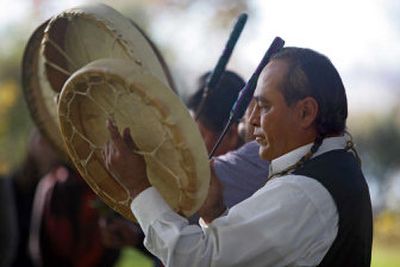Tribes dedicate Confluence Project site

PASCO – The deep pounding of drums and the clanging of a single bell marked the beginning of the newest Maya Lin project along the Columbia River, as area tribes blessed the riverside where the famed artist’s work will commemorate the Corps of Discovery trek more than 200 years ago.
The piece is one of seven by Lin commissioned by the Vancouver, Wash.-based Confluence Project to mark the 200th anniversary of the expedition led by Meriwether Lewis and William Clark. The works – only one has been completed so far – are to be scattered across 450 miles, primarily at the confluence of rivers.
The installation at Sacajawea State Park will include six circles and one piece in the shape of a tribal longhouse that will signify the historic gathering of Native American tribes at the confluence of the Columbia and Snake rivers.
The works are intended to signify the contrast between one day’s passage by Lewis and Clark and a lifetime of gathering by local tribes, Lin said.
“Confluence has been about how we think about things coming together,” she said. “Oftentimes, I’m finding the paths are divergent.”
All the Confluence Project sites are to be completed by 2008 at an estimated cost of $27 million. The works originally were scheduled to be in place in time for the official 2005-06 bicentennial celebration.
About 100 people attended Friday’s ceremony as a flock of ducks dove for fish on the shoreline. Members of the Wanapum, Umatilla, Cayuse and Walla Walla tribes pounded drums and chanted to bless the site, where construction will begin next year.
The event closed with the drumming of an honor song by several different tribes.
The artworks will serve as “footprints” for the native people of the region, Lin said. One circle might tell the story of tribes that gathered at the site, while another might discuss the geologic changes there.
The water level at the site today is about 15 feet higher because of dams on the river than it was when Lewis and Clark traveled through the area.
While the artwork is created, landscape architects and park officials will be working to restore the shoreline of the park, reconfigure some beaches and plant riparian plants to provide shade and aid juvenile salmon as they swim through the rivers.
“I’m just honored to have partaken in this incredible blessing ceremony, and now we have some work to do,” said Lin, who is perhaps best known for designing the Vietnam Veterans Memorial in Washington, D.C.
The event was particularly important to educate others about the various tribes’ roles in the region, said Antone Minthorn, chairman of the Confederated Tribes of the Umatilla Indian Reservation and board chairman of the Confluence Project.
The Lewis and Clark Bicentennial “has never been the most popular commemoration among Indian tribes, but many of them have participated because we believed we needed to have a voice,” Minthorn said.
The Confluence Project includes five sites in Washington and two in Oregon. The only one completed so far is at Cape Disappointment State Park, where the Columbia River flows into the Pacific Ocean at Ilwaco, Wash. The installation includes a basalt fish-cleaning station, trails, a viewpoint and interpretive plaques.